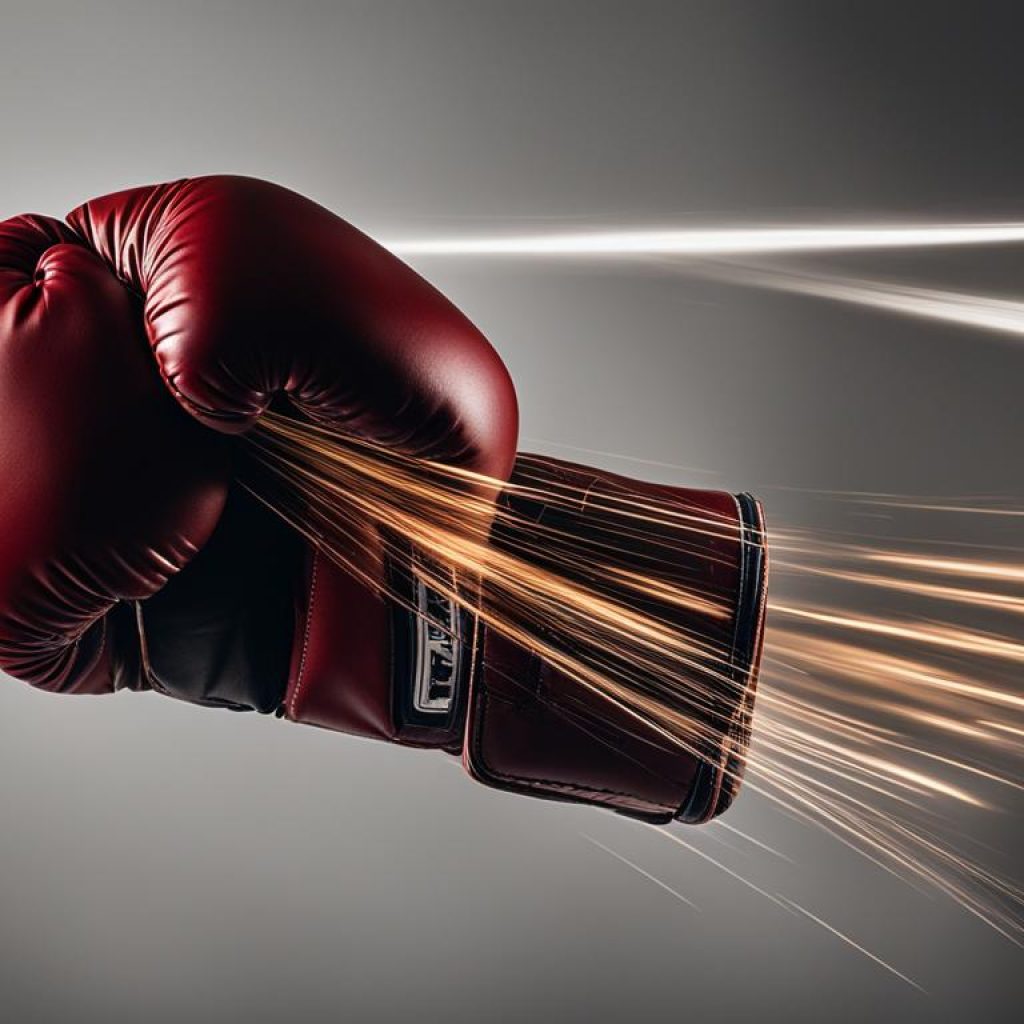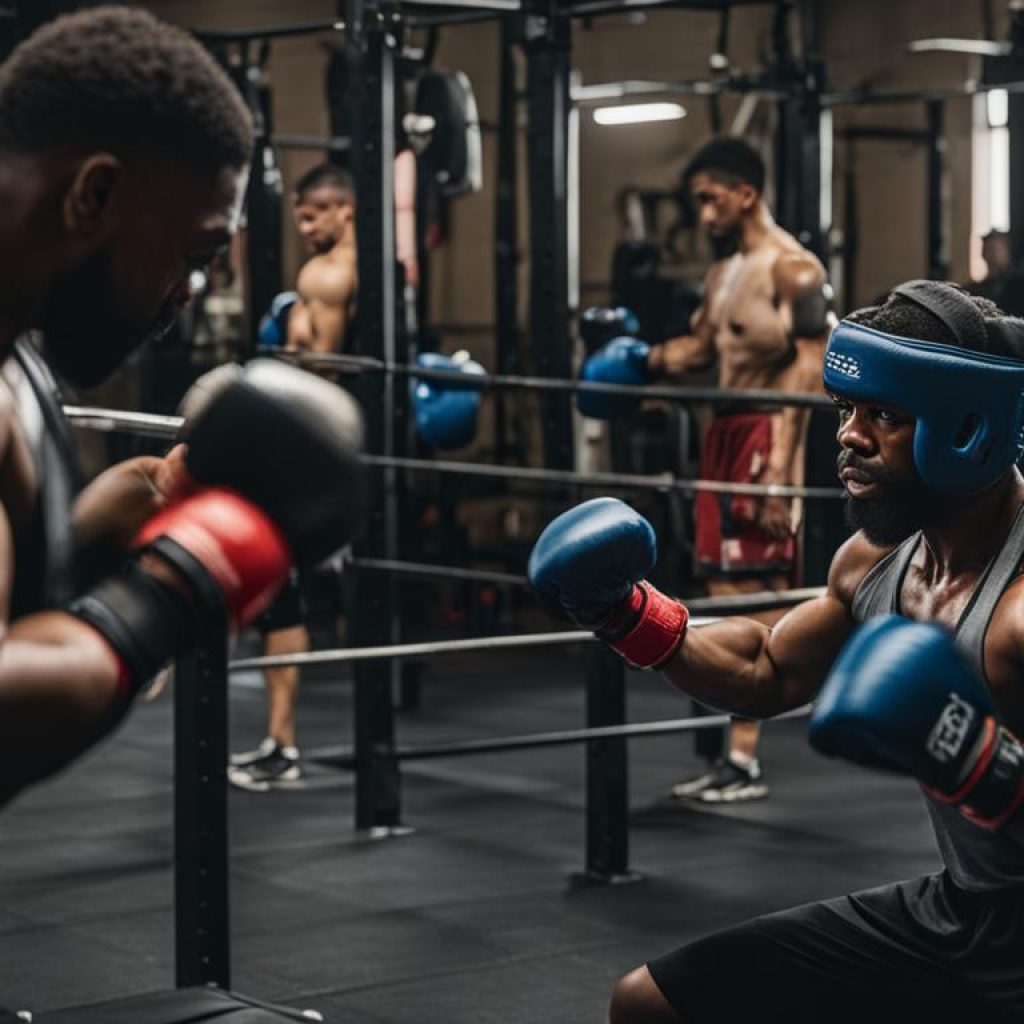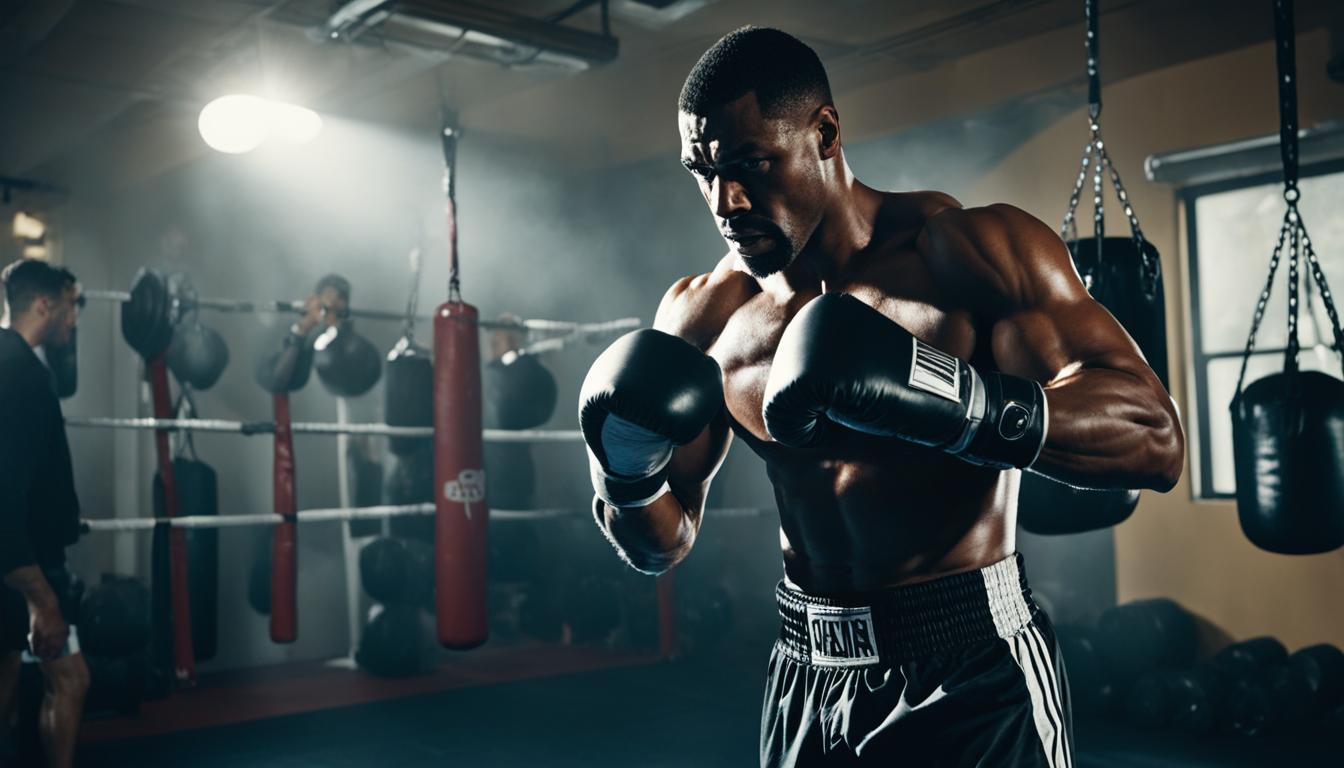Punching power is a vital tool for boxers, acting as a deterrent against opponents. Developing and improving punching power can be achieved through a combination of technique, speed, timing, strength training, and explosive shell. While some individuals may naturally possess great punching power, others can boost their punch through focused training and exercises. In this article, we will explore the essential building blocks of punching power and how boxers can become harder hitters in the ring.
Key Takeaways:
- Understanding the building blocks of punching power is crucial for boxers.
- Technique, speed, timing, strength training, and explosive shell are the key elements to focus on.
- Improving punching power requires consistent practice and dedication.
- Boxers can enhance punching power through sport-specific exercises and drills.
- Strengthening the neck and jaw can improve punch resistance and absorbance.
What is Punching Power?
In the world of boxing, punching power is the key to success. It refers to the ability to deliver impactful blows that can stun or even knock out an opponent. The goal is to make your opponent feel the raw strength and force behind your punches. While knockouts may be less common in amateur boxing, the ability to stun your opponent and make them aware of your power is crucial. Understanding the concept of punching power and its correlation with mass and velocity can help you develop your power and enhance your performance in the ring.
Knockout power in boxing is the ultimate testament to a boxer’s skill and technique. It is the ability to generate enough force in a single punch to render an opponent unconscious. Knockout punches are often characterized by their speed, precision, and devastating impact. However, it’s important to note that knockout power isn’t the sole measure of a boxer’s punching ability. Even if knockouts are less common in amateur boxing, possessing and improving punching power enables you to stun your opponents, gain their respect, and establish your dominance in the ring.
Punching power is not solely reliant on brute strength. It’s a combination of various factors, including technique, speed, timing, and strength training. Understanding these building blocks and working on each aspect can significantly improve your punching power.
Mass and velocity are two critical components of punching power. Mass refers to the weight behind your punches, while velocity relates to the speed at which your punches travel. The equation is simple: the greater the mass and velocity, the more power your punches will carry. By increasing your mass through strength training exercises and improving your speed through specific drills and training techniques, you can enhance your punching power.
Improving your punching power is a journey that requires dedication, practice, and a comprehensive approach. By focusing on the different aspects of punching power and consistently working on your technique, speed, timing, and strength training, you can steadily enhance your ability to deliver powerful and impactful punches.
So let’s delve deeper into each building block of punching power and explore how you can improve your skills in each area.
Building Block #1 – Technique
Technique is a crucial element in developing punching power. With proper technique, you can ensure that your punches land effectively and minimize the chances of your opponent defending against them. One key aspect of technique is harnessing explosive thrust from the lower body, specifically the balls of the feet, to maximize the mass delivered behind each punch.
Mastering technique allows you to generate power while maintaining balance and control, both when landing shots and avoiding counters from your opponents. Good technique is essential for increasing punching power and becoming a harder hitter in the ring.
Explosive Thrust and Balance
When executing a punch, focus on driving power from your lower body, transferring the energy through your core, and ultimately delivering it through your fists. By using explosive thrust from the balls of your feet, you can maximize the force behind each punch. This explosive movement not only generates power but also helps maintain balance, allowing you to recover quickly after throwing a punch.
Proper balance is crucial for delivering powerful punches. It enables you to stay grounded, maintain stability, and transfer your body weight effectively. This balance, combined with explosive thrust, ensures that you can generate maximum power with each punch.
Maintaining Control and Precision
Technique also plays a vital role in maintaining control and precision during your punches. By focusing on the correct form and executing each punch with precision, you can increase the effectiveness of your strikes. A well-executed punch not only delivers power but also increases the chances of it landing accurately on your opponent.
Boxing is a sport of finesse, where precision matters. By working on your technique, you can improve your ability to hit your target with more accuracy, making your punches more effective.
Practice and Consistency
Developing proper technique requires practice and consistency. By incorporating technique drills and focusing on the correct form in your training sessions, you can train your muscles and muscle memory to execute punches with maximum power and efficiency.
Consistently working on your technique is essential to maintain the level of power and control you desire. Over time, as you become more comfortable with the correct form and execute punches with proper technique, you will see a noticeable improvement in your punching power.
Remember, technique is a fundamental building block for improving punching power. By mastering the proper form, utilizing explosive thrust and balance, and maintaining control with precision, you can significantly increase your punching power and become a harder hitter in boxing.
Building Block #2 – Speed
Speed is a critical component for increasing punching power in boxing. When a punch travels faster, it delivers more power, provided the technique remains consistent. Additionally, faster punches have a higher chance of catching opponents off guard and landing effectively. To develop and improve punching speed, boxers can incorporate specific drills and exercises that focus on quickness and explosiveness.
Here are some boxing drills for power and increasing punching speed:
- Shadow Boxing: This drill allows boxers to practice their punches without an opponent, focusing on speed, technique, and accuracy.
- Double-End Bag: This small target bag moves unpredictably, challenging boxers to improve their reflexes and speed.
- Speed Bag: The speed bag is another valuable tool for developing hand-eye coordination, rhythm, and quick punches.
- Jump Rope: Jump rope exercises help improve footwork and overall coordination, which contributes to faster punches.
- Focus Mitts: Working with a partner or coach using focus mitts allows boxers to practice their speed and accuracy in combination punching.
By incorporating these boxing drills for power and speed into their training routine, boxers can significantly enhance their overall power and effectiveness in the ring.
Quote:
“Speed kills in boxing. When you have speed, you have the ability to deliver lightning-fast punches that can catch your opponent off guard and generate significant power.” – Muhammad Ali
Comparison of Different Boxing Drills for Power and Speed
| Boxing Drill | Benefits |
|---|---|
| Shadow Boxing |
|
| Double-End Bag |
|
| Speed Bag |
|
| Jump Rope |
|
| Focus Mitts |
|

Developing speed is an essential aspect of increasing punching power in boxing. By incorporating these drills and exercises into their training regimen, boxers can improve their speed, accuracy, and overall effectiveness in the ring.
Building Block #3 – Timing
Timing plays a crucial role in the art of boxing, especially when it comes to generating power in your punches. By mastering the art of timing, you can significantly enhance your punching power and increase your chances of landing effective shots.
When it comes to timing, the key is to land your punches when your opponent’s mass is moving towards you or when they are off-balance. By capitalizing on these moments, you can deliver powerful punches that have a greater impact.
Even the slightest movement from your opponent can create opportunities for you to showcase your power. By honing your timing skills, you’ll be able to spot these openings and deliver devastating blows.
Developing timing requires practice and experience. Regular sparring sessions and competitive bouts provide the ideal environment to sharpen your timing abilities. The more you engage in real-life scenarios, the better you’ll become at reading your opponent’s movements and capitalizing on them.
Mastering timing not only gives you an advantage in terms of power but also allows you to land shots with precision and accuracy. It’s a skill that sets elite boxers apart from the rest.
Remember, timing is a skill that can be developed with dedication and practice. So, make timing an integral part of your training regimen, and watch your punching power soar to new heights.
| Benefits of Mastering Timing | How to Improve Timing |
|---|---|
|
|
Building Block #4 – Strength Training
Strength training is a crucial aspect of enhancing punching power in boxing. By focusing on sport-specific exercises that target the muscle groups utilized in throwing punches, boxers can effectively increase their overall power and performance in the ring.
When it comes to strength training for boxing, it’s important to pay attention to specific muscle groups, including the calves, quads, abdomen, chest, shoulders, lats, triceps, and forearms. These muscles play a key role in generating power and delivering strong punches.
To simulate the resistance experienced during punching, incorporating resistance bands into strength training routines can be highly beneficial. These bands provide an extra challenge and help boxers develop the necessary strength to cope with resistance while throwing punches.
A well-rounded strength training program for boxing should prioritize the development of core strength and the specific muscle groups relevant to the sport. This can be achieved through exercises such as squats, deadlifts, lunges, bench press, shoulder press, lat pulldowns, tricep dips, and forearm curls.
Table: Sample Boxing Strength Training Exercises
| Exercise | Muscle Group |
|---|---|
| Squats | Quadriceps, Hamstrings, Glutes |
| Deadlifts | Erector Spinae, Glutes, Hamstrings |
| Lunges | Quadriceps, Hamstrings, Glutes |
| Bench Press | Chest, Triceps, Shoulders |
| Shoulder Press | Shoulders, Triceps |
| Lat Pulldowns | Lats, Biceps |
| Tricep Dips | Triceps |
| Forearm Curls | Forearms |
By incorporating a combination of these exercises into their training regimen, boxers can develop the necessary strength and power to deliver impactful punches. It’s essential to work with a qualified strength and conditioning coach to design a program that caters to individual needs and goals.
With consistent and focused strength training, boxers can significantly improve their punching power, giving them a competitive edge in the ring.

Building Block #5 – Explosive Shell
The explosive shell is a crucial element in improving punching power and becoming a harder hitter in boxing. It involves the activation of muscles just before impact, allowing boxers to generate and absorb power effectively. By developing explosive power in the muscles used for throwing punches, boxers can maximize the force behind their strikes.
To enhance the explosive shell, it is important to focus on strengthening specific muscle groups involved in punching. The upper and lower abdomen, obliques, and latissimus dorsi play a significant role in generating power. By incorporating targeted exercises that engage these muscles, boxers can increase their punching power and deliver stronger punches in the ring.
One effective exercise for the upper abdomen is the medicine ball slam. Stand with your feet shoulder-width apart, hold a medicine ball at chest level, and explosively slam it down to the ground while engaging your core. This exercise helps develop explosive power in the abdomen, improving overall punching power.
For the lower abdomen, leg raises targeting the lower abs can be beneficial. Lie flat on your back, raise your legs until they form a 90-degree angle with your hips, and lower them back down. This exercise strengthens the lower abdominal muscles, contributing to a more explosive shell.
Another important muscle group to focus on is the obliques. Russian twists are a great exercise for targeting the obliques. Sit on the ground with your knees bent, feet elevated slightly off the ground, and twist your torso from side to side while holding a medicine ball or weight. This exercise helps strengthen the obliques, enhancing the rotational power in punches.
Lastly, the latissimus dorsi, commonly known as the lats, are essential for generating power in punches. Pull-ups and lat pulldowns are effective exercises for strengthening the lats. By developing strong lats, boxers can improve their ability to deliver forceful punches.
“The explosive shell is the key to maximizing punching power in boxing. By focusing on strengthening the upper and lower abdomen, obliques, and lats, boxers can enhance their explosive power and become harder hitters.”
Neck and Jaw Strengthening
Strengthening the neck and jaw is a key component in becoming a harder hitter in boxing. By enhancing these areas, boxers can improve their ability to absorb punches and minimize damage. A strong neck provides stability, reducing the impact of punches to the face, while a strong jaw helps lessen the shock from a punch.
There are specific exercises that can be performed to strengthen the neck and jaw. One effective exercise is neck-ups with weights, which involves lying on your back and lifting your head off the floor while holding a weight against your forehead. This exercise targets the neck muscles and helps build resistance to punches.
Another technique to strengthen the jaw is jaw clenching. Simply clenching your jaw tightly for a few seconds and releasing it repeatedly can help fortify the muscles around your jaw. This exercise contributes to improved punch resistance and overall durability in the ring.
By incorporating neck and jaw strengthening exercises into your training routine, you can enhance your ability to take hard punches and ultimately become a harder hitter in boxing.
Rolling with Punches and Defensive Techniques
When it comes to boxing, defensive techniques are just as important as offensive ones. One key defensive tactic is rolling with punches, which involves moving your head in the direction of an incoming punch to minimize its impact. By rolling with the punch, you can lessen the force and follow-through, reducing the chances of getting hurt in the process.
This advanced defensive maneuver requires practice and impeccable timing. It’s crucial to anticipate and react to your opponent’s punches, allowing you to effectively roll with them. Incorporating rolling with punches into your training sessions, such as pad work and sparring, will improve your ability to absorb punches and maintain your effectiveness in the ring.
“Rolling with punches is like dancing with your opponent. By seamlessly moving with their strikes, you dissipate their power and gain the upper hand. It’s a crucial skill to master if you want to become a harder hitter in boxing.”
In addition to rolling with punches, mastering blocking and parrying techniques can significantly reduce the damage inflicted by your opponent’s strikes. Blocking involves using your arms to shield yourself from punches, while parrying involves redirecting the opponent’s punch away from its intended target. Both techniques require excellent reflexes and timing.
Integrating these defensive techniques into your training regimen not only enhances your ability to defend against punches but can also give you a strategic advantage in the ring. By minimizing the impact of your opponent’s punches, you can keep yourself in the fight and maintain your hard-hitting capabilities.
The Importance of Defensive Techniques
While developing power in your punches is crucial, it’s equally important to focus on defensive techniques. A well-rounded boxer is both a formidable attacker and a resilient defender. By honing your defensive techniques, you can effectively neutralize your opponent’s offense and protect yourself from getting hit, allowing you to unleash your hard-hitting punches when the opportunity arises.
Remember, boxing is a sport that requires a balance between offense and defense. By incorporating defensive techniques like rolling with punches, blocking, and parrying into your training, you’ll not only improve your ability to absorb punches but also enhance your overall boxing skills.
Conclusion
Mastering the art of punching power in boxing requires a comprehensive approach that encompasses technique, speed, timing, strength training, and defensive skills. While some may have a natural inclination for power, anyone can enhance their punching ability through focused training and development of the building blocks outlined in this article.
By diligently implementing these strategies and consistently practicing them, boxers can become harder hitters in the ring, increasing their chances of delivering powerful and effective punches. Utilizing proper technique, honing speed and timing, incorporating strength training exercises, and mastering defensive techniques all contribute to the growth of knockout power in boxing.
Remember, becoming a harder hitter is not limited to those with innate power, but rather depends on dedication and a well-rounded training regimen. With perseverance and the right mindset, anyone can boost their punch and make a significant impact in the ring.
FAQ
What is punching power?
Punching power refers to the ability to deliver powerful and impactful punches in boxing. It is the force behind a punch that can stun or knock out an opponent.
How can I improve my punching power?
To enhance your punching power, you can focus on improving your technique, speed, timing, strength training, and explosive shell. These building blocks can help you become a harder hitter in the ring.
What role does technique play in punching power?
Technique is crucial for generating power in punches. By utilizing proper form and execution, you can maximize the mass delivered behind your punch and increase your overall power.
How does speed contribute to punching power?
Speed plays a significant role in increasing punching power. The faster your punch travels while maintaining proper technique, the more power it will deliver. Faster punches are also more likely to catch opponents off guard and land effectively.
How does timing affect punching power?
Timing is essential in generating power in boxing punches. By throwing your punches when your opponent is off-balance or their mass is moving towards you, you can significantly increase your punching power. Mastering timing allows you to create openings and deliver powerful shots.
What is the importance of strength training for punching power?
Strength training is crucial for enhancing punching power. By focusing on specific muscle groups used in throwing punches, such as the calves, quads, abdomen, chest, shoulders, lats, triceps, and forearms, you can develop the necessary strength to generate more power behind your punches.
What is the explosive shell in boxing?
The explosive shell refers to the activation of muscles just before impact, allowing boxers to generate and absorb power effectively. By developing explosive power in the muscles used for throwing punches, such as the upper and lower abdomen, obliques, and latissimus dorsi, boxers can enhance their punching power.
How can strengthening the neck and jaw improve punching power?
Strengthening the neck can stabilize the head, reducing the impact of punches to the face. A stronger jaw can help absorb and lessen the shock from a punch. Exercises targeting the neck and jaw can contribute to improved punch resistance and overall ability to take hard punches.
What are rolling with punches and defensive techniques?
Rolling with punches involves moving the head in the direction of a punch to minimize its impact. It is an advanced defensive tactic that requires practice and timing. Additionally, mastering blocking and parrying techniques can help minimize damage from punches. Incorporating these defensive techniques into training sessions can improve a boxer’s ability to absorb punches and maintain effectiveness in the ring.
How can I become a harder hitter in boxing?
By focusing on the building blocks of punching power, such as technique, speed, timing, strength training, and defensive techniques, you can become a harder hitter in boxing. Consistently practicing and developing these aspects will help increase your power and effectiveness in the ring.
Source Links
- https://darustrong.com/increase-punching-power/
- https://www.myboxingcoach.com/punching-power-improve/
- https://evolve-mma.com/blog/7-ways-to-train-yourself-to-withstand-hard-punches/
boost your punch: become a harder hitter
Last modified: December 21, 2023




